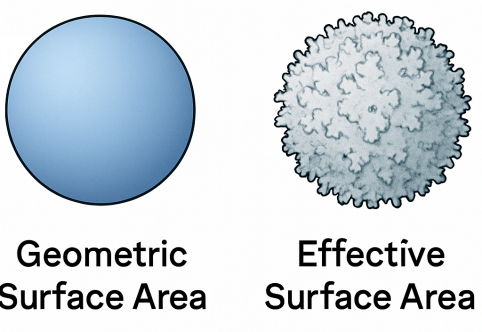Does Surface Roughness Increase Surface Area? A Technical Guide
 Apr 30,2025
Apr 30,2025

Although much importance is not often given to surface roughness, but it can be a key design parameter in certain applications. Surface roughness can increase overall effective surface area and it can also manipulate the coefficient of friction. Surface roughness is also pertinent from the aesthetics point of view. Let's explore it a bit more to get a better understanding.
Surface Roughness and Surface Area: Core Definitions
A question comes into mind: "What does surface roughness indicate?" Actually, it gives an indication about the irregularities and texture on a surface. It can be due to material properties and the manufacturing process. It affects the frictional behavior, adhesiveness and aesthetics of the surface.
What Is Surface Roughness?
Surface roughness is the deviation of the surface from its ideal form. As an example, an perfect sphere's surface would be 100% smooth having no crests and troughs on it. The deviation from the ideal from is the surface roughness.
Key Metrics (Ra, Rz, Rq, etc)
- Ra: It is the arithmetic mean of the deviation of peaks and valleys on the surface along a line.
- Rz: It is the mean of five highest peak and five lowest valleys along a line on the surface.
- Rq: It is the root mean square of surface deviations.
Standards (ISO, ASME)
- ISO 4287 / ISO 25178
- ASME B46.1
Differentiating Roughness, Waviness, and Form
Roughness means the slight deviation of the surface from the ideal form. Waviness has more widely spaced surface deviations. It is like a consistent pattern. Form describes an overall shape deviation. For, e.g a round pipe not being completely round.
Surface Area: Geometric vs. Effective
The effective surface area is always more than the geometric surface area, because the effective surface area also include increase due to roughness. Please see the below illustration as an example.

What Is The Relationship Between Surface Area And Surface Roughness?
Surface area and surface roughness are directly proportional to each other. Geometric surface area does not account for peaks and valleys due to surface roughness. Whereas, actually the surface areas is always more. The Rf factor is used to describe it:
Rf =Real Area/Geometric Area
A value of Rf greater than 1 shows that real are is more than the geometric area.
Role of Peaks and Valleys
An uneven surface profile contains some peaks and some valleys. This topography can be helpful in various things. It can provide good adhesion to coatings, a better tissue growth for medical implants and a faster heat transfer in heat sinks etc.
When a Rough Surface Doesn't Always Translate to More Functional Area
A rough surface does not always mean a more functional area. As an example, a surface coating can fill all the voids and make the surface smooth. In case of softer metals, peaks can compress under surface conditions.
The Science Behind Roughness and Area
Quantifying roughness is important because it can increase the effective surface surface area for certain applications like adhesion of coating or ion transfer in a reactor. In other applications lowering roughness might be more important.
Fractal Geometry and Surface Expansion
Fractals are like protrusions on the surface that increase the overall area. As an analogy, a stretched peice of crumpled paper would apparently cover the sam area but if all fractals rea taken into account the effective surface area would be much larger.
What Is The Roughness Factor (Rf) Of Surface Area?
Rf quantifies surface roughness. A larger Rf would mean more surface area for a coating adhesion. Similarly, a larger Rf could mean more area for ion transfer in a battery.
Exceptions: Closed Pores and Non-Accessible Features
Sometime a large Rf doesn't mean more functional area. As an example, over-machined aluminum parts in CNC may have trapped air pockets or sub surface cavities that doesn't contribute in functionality.
Surface Roughness In CNC Machining Process
Controlling surface roughness in CNC machining processes is very important. It can impact both the functionality and aesthetics of a product. Manufacturers and customers often agree upon a value of Rf for surface finish in CNC machining orders.
Key Factors Influencing Surface Roughness in CNC
Key factors that influence the surface roughness are tool sharpness, tool type, cutting speed, feed rate and material properties.
Tool Selection and Geometry
The choice of cutting tool strongly affects surface roughness:
- Ball-nose end millsproduce lower Ra values because their rounded tips smooth out surface transitions
- Flat end millscan create higher Ra values.
Cutting Parameters
| Cutting Parameter | Effect on Surface Finish (Ra) | Practical Rule of Thumb |
|---|---|---|
| Feed Rate (mm/rev or mm/tooth) | Higher feed = rougher finish; lower feed = smoother finish. |
Halve the feed to drop Ra ~25 – 30 % on most steels. |
| Spindle Speed (rpm) | Higher speed improves finish until tool rub or heat limits. | Increase rpm 15 – 20 % if chips are long and Ra is above spec. |
| Depth of Cut (DOC) | Lighter DOC reduces tool pressure → finer finish. | For finishing, use DOC ≤ 0.5 × tool Ø (milling) or ≤ 0.2 mm/rev (turning). |
Rule of Thumb:
"Use light feed, high speed and shallow cut for smooth surfaces."
Please check out the below link about how CNC machining parameters can affect roughness:
Material Behavior
Soft Metals like aluminum have a Ra in the range of 0.4 – 1.6 µm and hard alloys like Ti6Al4V have an Ra in the range of 0.8 – 3.2 µm. This difference arises due to difference ease of machinability.
Common CNC Surface Roughness Defects
- Chatter Marks and Vibration
- Burrs and Microtearing
- Inconsistent Roughness Across Features
How To Measure Surface Roughness?
Surface roughness measurement is important for meeting quality standards and product specification for different applications. Tools like contact profilometry and optical profilometry are used to measure the surface roughness.
Tools: Profilometers vs. Optical Scanners
|
Feature |
Contact Profilometer |
Optical Profilometer |
|
Method |
Stylus traces surface |
Light or laser scans surface |
|
Best For |
Hard parts |
Soft, delicate, or coated parts |
|
Output |
2D line profile |
3D surface map |
|
Speed |
Slower |
Faster |
|
Risk of Damage |
Possible on soft materials |
None |
|
Cost |
Lower |
Higher |
What Are Surface Roughness Symbols?
|
Symbol |
Meaning |
Example |
|
⏤ |
Surface finish required |
– |
|
⏤ Ra 1.6 |
Roughness value (Ra in µm) |
Ra ≤ 1.6 µm |
|
⏤⌝ |
Material removal required |
Machining needed |
|
⏤⌞ |
Material removal prohibited |
Keep as-cast/forged |
|
→ |
Lay parallel |
Milling marks |
|
┴ |
Lay perpendicular |
Turning marks |
|
X |
Laymultidirectional |
Polishing |
|
C |
Lay circular |
Lathe parts |
|
R |
Lay radial |
Discs or wheels |
Common CNC Measurement Errors
Errors can occur in the roughness measurement value due to:
- Improper stylus settings
- Coating on surface
- Wrong parameters settings
- Unintended vibrations
Surface Roughness vs. Surface Area in Critical Industries
Surface roughness has a dominant impact on the effective surface area. Several applications require a high functional area for enhancing productivity. Some of the examples are discussed here.
Energy Storage: Roughness and Battery Performance
An optimum surface roughness optimizes the functional area for enhanced battery performance. The more the surface area, the better the ion exchange and the better the charging, storage and discharging of the battery.
Aerospace: Roughness for Aerodynamics and Cooling
Surface roughness influences the aerodynamics of the aircrafts. The more the roughness the more the drag. Roughness increases the surface area for faster heat transfer in engines of aircrafts.
Improve Roughness for CNC Projects: Material-Specific
Understanding the machinability characteristics of materials is important. Each material responds differently to cutting forces, heat generation, and tool interaction. As a results different materials get different roughness values under same CNC parameters.
Aluminum Alloys: Balancing Speed and Finish
Aluminum alloys are relatively softer. Hence, they allow for a high machining speed. Normally, Ra values in the range of 0.4 - 1.6 µm is possible.
Stainless Steel: Managing Hardness and Heat
Stainless steel is comparatively hard and work hardens under excessive pressure. Thus, hard and sharp tools, moderate speeds and proper application of coolant is necessary. Normally, Ra value in the range of 0.8 - 3.2 µm is possible
Engineering Plastics: Preventing Melt and Tearing
Engineering plastics are prone to melting, smearing, or tearing due to low thermal conductivity and high plasticity. Special tools and optimum speeds are necessary. Normally, Ra value in the range of 0.8 – 2.4 µm is possible
Conclusion
Surface roughness is a critical parameter for maintaining product functionality in various applications like energy storage in batteries or coating adhesion on the surface. Roughness measurement can be carried out using contact or non contact profilometry techniques. The CNC machining parameters can be optimized to match the require Ra values.
FAQs
Does surface roughness increase surface area?
Surface roughness increases the effective surface area. In some cases features like sub surface voids or cavities although increase the surface area but do not contribute to the functionality of the product.
How toolpaths affect roughness?
Toolpaths affect roughness by determining the pattern, overlap, and direction of tool contact.
Is roughness always perform better?
Not necessarily. In some cases, low roughness is required, for example, polishing is required for aesthetic purposes.
 Tel/WeChat:
Tel/WeChat:  Email:
Email: 
 Home
Home
 NPI Manufacturing Guide: Concept to Production|CNC
NPI Manufacturing Guide: Concept to Production|CNC 







